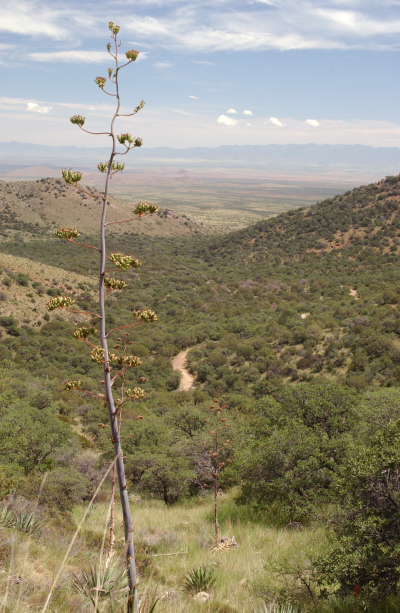Part
VI --- A Meeting of Minds -- cont.
The stop at Sulphur
Springs was to have been a very brief pause, allowing them to water their
horses, obtain grain for same and perhaps for their own use purchase tobacco
and hardtack (a hard square biscuit or cracker that is made with flour
and water only; unleavened and unsalted bread.) But Howard was not
happy to see that the station was temporarily hosting a guard of some 10
or 12 soldiers who were present to escort a wounded man to Fort Bowie (the
man had been shot through both arms during an altercation with hostile
Apaches). This greatly concerned him, as he wanted to avoid the impression
that he had any association with the military while on this mission.
He was aware of Cochise's acute distrust of American soldiers and it was
taken for granted that they would be under constant surveillance by eagle-eyed
lookouts. Everyone in the group felt a shudder of dread, unsure as
they were that they had not already been spied. They were forced
to waylay their departure till the fall of night, making the march to the
Dragoon foothills that much more perilous.

This
is how the Dragoon Mountains would have looked to Howard's party from their
vantage point
at
Sulphur Springs as sunset approached on September 29, 1872. The only
difference
would
have been a great deal more lush grass in the foreground and much less
mesquite.
The
low saddle toward the left of this view is Middlemarch Pass, where they
would cross over to the west side of
the
range. At the other end of the photo is Mount Glenn, the tallest
point in the Dragoons.
Just
to the left of that peak can be seen another low dip in the silhouette
of the range.
This
is East Stronghold Canyon, which connects directly to West Stronghold Canyon.
Cochise
and his band were camped in this general area, on the west side.
Howard's
approach was being monitored by sentries posted near the top of Mount Glenn.
According
to
Sladen, the person in command of this outpost was Cochise's sister, whose
name is not known today.
|
Sladen writes in
his journal that a march of 9 or 10 miles was made, taking a heading that
targeted the southern half of the Dragoon range. Ponce and Chie at
this point probably assumed (correctly as it turned out) that Cochise was
camping on the west side of the mountains, and they may have even known
his exact whereabouts by this time. If so, they did not make this
knowledge known to their charges. It can be assumed, safely I believe,
that Howard's party was guided by their young Indian companions to the
pass south of where they thought Cochise could be found so as not to approach
the encampment too directly. The path they followed took them to
an area near present day Pearce, on the way to Middlemarch Pass.
Making a dry camp, they spent the remainder of the night of September 29
here and resumed their travel next morning, heading up the pass (the current
Middlemarch Road most likely follows much the same path as the original
trail of the same name, taking a winding course that provides fantastic
views of Sulphur Springs Valley along the way).
 |
Looking
back over Sulphur Springs Valley from a point near the top of Middlemarch
Pass. View is looking directly east, with the Chiricahua Mountains
visible in the distance. |
Ponce and Chie both
exhibited great caution and it was evident to Howard, Jeffords and Sladen
that they were likely being monitored every step of the way. Signal
fires were lit with regularity as the group made their way up and over
the pass. Eventually they descended on the west side of the Dragoon
range, stopping to rest at a scenic spot with a beautiful stream running
nearby. The exact location of this brief layover is open to debate
for the time being, though John Rockfellow, as result of discussions with
Tom Jeffords years later, came to the conclusion that the site was at or
near Sycamore Springs. We do know that Alice Rollins Crane, during
her expedition to the area with Jeffords in 1895, took a photo of the spot
and included it with others in a letter to General Howard -- who wrote
back verifying that she had correctly identified the place. This
photo, and all the others save one (the picture of the "big rock"), have
so far eluded discovery by modern historians -- a condition I personally
would like to reverse.
|
 .
. . . .
.
. . . . .
.
 .
. . . .
.
. . . .